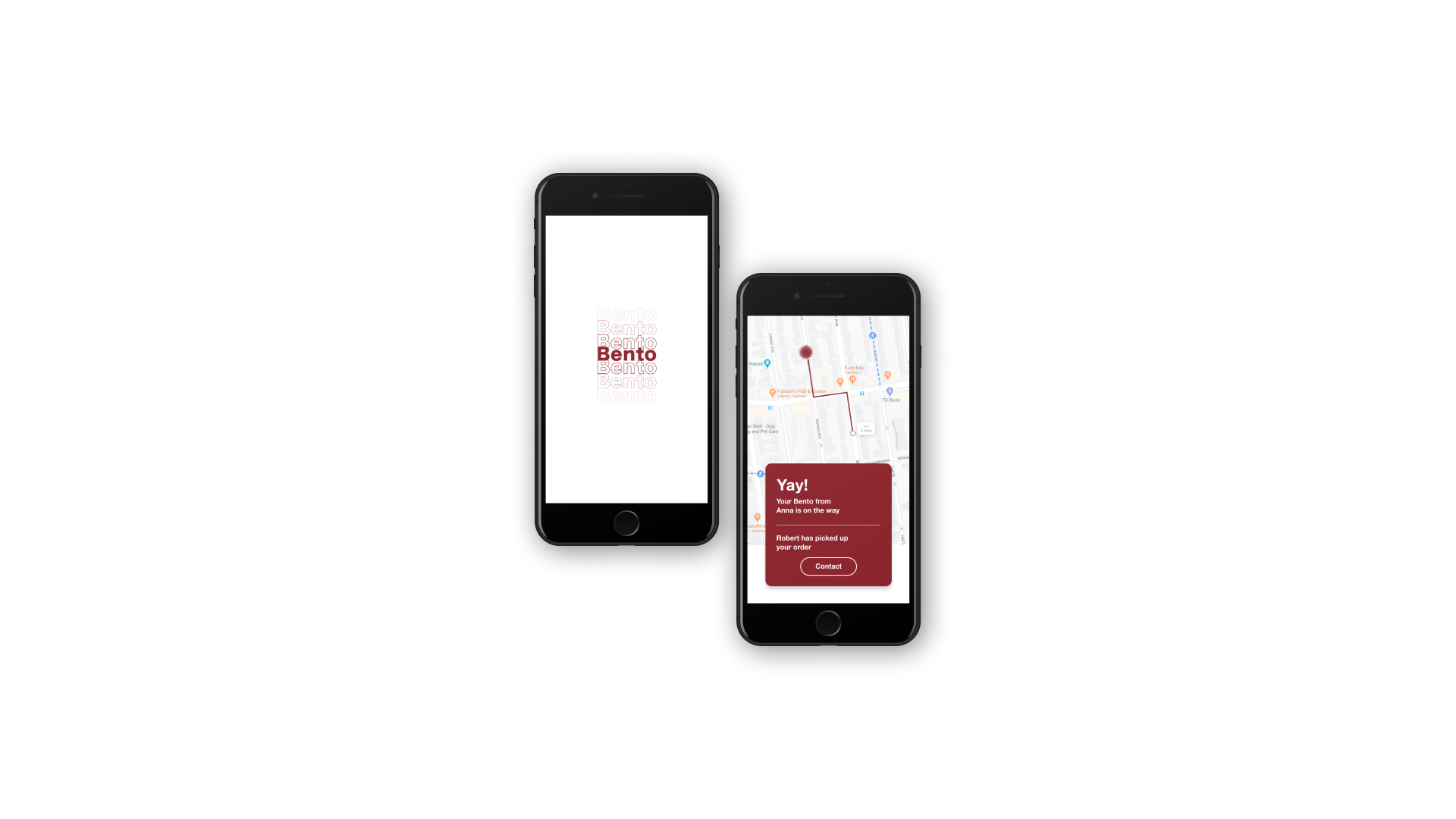
Bento, Sustainable Dining Service to Your Door
A sustainable food delivery system that aims to alleviate unnecessary food waste and promotes healthy eating to young professionals.
Scope
UX Research, Service Design, UI Design
Team
Self-directed
Duration
2 weeks
Tools
Adobe XD, Illustrator, Photoshop
Problem
Working professionals are facing challenges to balance busy work life and healthy diets, so many are relying on food delivery services and fast food for convenience. However, the rising trend of food delivery apps and the pre-existing fast food culture aggravate environmental and health crises, such as excessive food consumption and packaging waste.
Goals
Understand the current issue from the aspects of environmental impacts, food delivery services, and target users’ needs. Optimize the service flow of the food delivery system by mitigating unnecessary food and packaging waste.
Solutions
Process
Remapped the system model of the current food delivery service to offer healthier food choices and reduce the use of single-use utensils: users can plan out their weekly meal plans with the food makers they choose, and the food makers will put food in reusable containers for delivery. Once done with their meals, users will assign empty meal box pickup in the app.
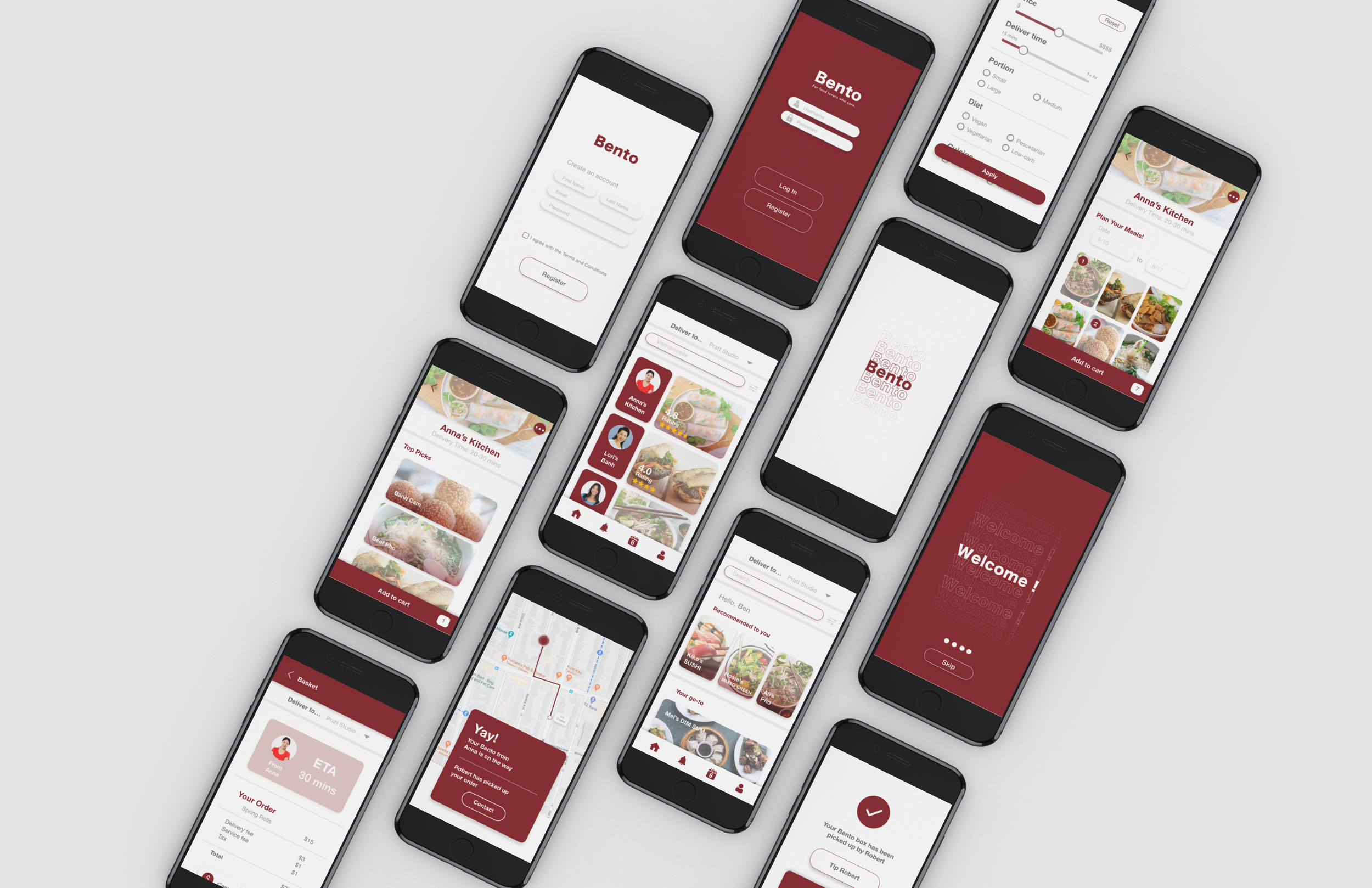
KICKOFF
Food Waste Is Bigger Than We Thought
The consumption of fast food has long been a problem in the US. Despite its negative impacts on society and culture, it has a firm grip over a large part of America because of its convenience, and the rise of food delivery app services is the cherry on top. Here are some quick facts:
Food, plus packaging, make up about 45% of all the materials in U.S. landfills
68 million people McDonald’s feeds every day around the world is more than the population of Spain.
The problem working professionals run into is their reliance on snack foods and fast foods that are high in fat and have little nutritional value.
In this project, I took a goal-directed method, asking initial key questions and conducting multi-methodology research to further understand people’s needs, especially during this time of uncertainty. How do we facilitate a more sustainable dining experience while maintaining the convenience of food delivery? What are ways that we can curate a community-driven ecosystem? Examining existing food delivery services, case studies, and academic research, I want to create an eco-friendly system to bridge young professionals and their relations with food, minimizing unnecessary food waste.
OBSERVE I
What Is Chinese Take-Out Box?
As a loyal customer of food delivery service, I decided to pick a common take-out food packaging that I like and further investigated its history and product life cycle.
Looking into Chinese cuisine that often comes with soup and sauce, I’m intrigued by its shape and functionality, also known as oyster pail — a folded, waxed, or plastic-coated paperboard container originally made for holding oysters. The design is widely used by Chinese restaurants primarily throughout the US, to package hot or take-out food. It is also commonly seen in other western countries, such as Australia, New Zealand, and England. However, it hasn’t been a container of choice in China and other Asian countries with a dominant population of ethnic Chinese.
OBSERVE II
Production Process
To have a better understanding of food packaging waste, I mapped out the life cycle of a Chinese take-out box, from raw materials to its end of life.
I then realized the process is taking a lot from nature, but also the amount of toxic waste being produced for a one-time use product is significant. After consulting the professionals at SIMS Recycling Center, I‘ve also learned that this paper-made design is not recyclable due to the plastic coating, which is designated to prevent leaking. In turn, the potential environmental impacts caused by production include:
habitat alterations
global warming
ecotoxicity
minerals
fossil fuels
CASE STUDIES
What Are Some Existing Solutions?
Looking specifically at Asia for inspiration on different packaging methods for food delivery; through materials, culture, and user research, I found three clever and environmentally-friendly solutions in South Korea, Taiwan, and India.


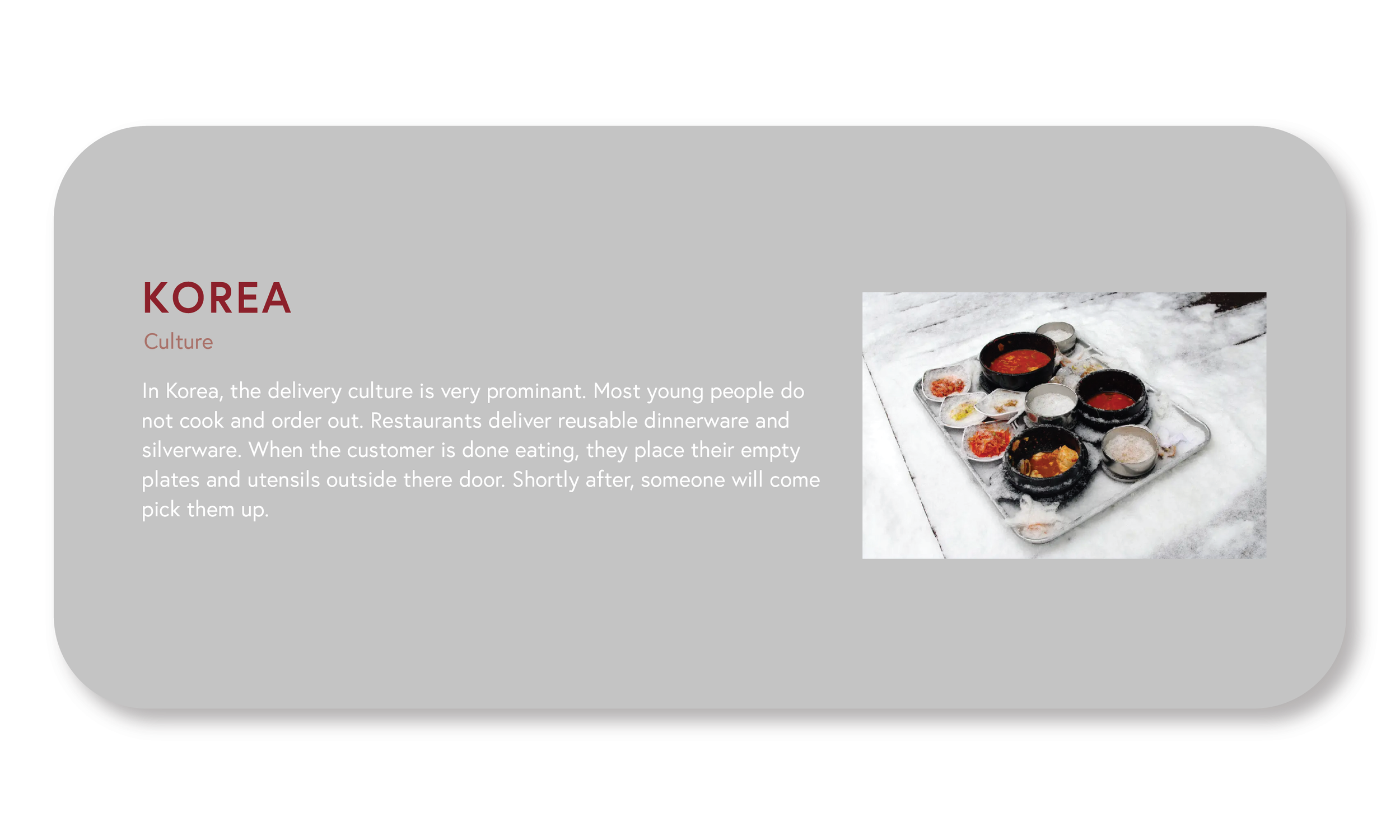
To create a sustainable food delivery system that reduces unnecessary food waste and promotes healthy eating to young professionals.
“How might we…”
1. “How might we get people to be more excited about balanced diets and sustainable lifestyle?”
2. “How might we make this a seamless experience, corresponding to the current food delivery ecosystem?”
3. “How might we make it more engaging, increasing the users commited to the app?”
DESIGN OBJECTIVE
Goals & Opportunities
COMPETITIVE ANALYSIS
Current Delivery Services Pros & Cons
Allocating Bento’s position on the market, I conducted an analysis of current competitors to evaluate popular features based on user feedback and identify missing opportunities that could possibly be implemented.
From the research, I found that high service fees could be a concern to many users, which subscriptions like DashPass can mitigate the accelerated price at checkout. Functions that suggest different restaurants not only help promote restaurants and eateries but also inspire users to try new options. Among these 4 popular food delivery apps, the lack of visuals on menus could potentially limit users’ attempts to order something different.
Efforts vs Environmental Consciousness
I made a competitive matrix to plot the competition on two axes: environmental consciousness and efforts to meal prep. I noticed that delivery services like Grubhub and Uber Eats have more stakeholders between the age of 20-40 than meal kit services (ie. Blue Apron). The reason is that some still find it challenging to keep up with cooking after a long day at work.
As to environmental consciousness, DoorDash and Seamless are the only two companies that offer an eco-friendly feature, which provides options for not including utensils.
DESIGN METHODOLOGY
User Behavior
To create a sustainable ecosystem for food delivery and its users, it’s important to have a better grasp of its user routines and interests.
The Fogg Behavior Model demonstrates an inverse relationship between motivation and ability. When the action is complex, users require more motivation, and thus it is crucial to make the minimum action (in this case: returning reusable utensils after dining) as effortless as possible for the users.
Moving forward…
Finding the minimum effort users take in anticipating their orders and creating a system that motivates users to adapt to this novel food delivery service.
AFFINITY DIAGRAM
Identify the Scope
I want to understand how users make meal choices via delivery service and allocate their needs and wants, as well as features that users care the most about. I interviewed 4 working professionals from the age of 21 to 28 who heavily rely on food delivery and also talked to multiple casual users.
STAKEHOLDER MAPPING
User Persona

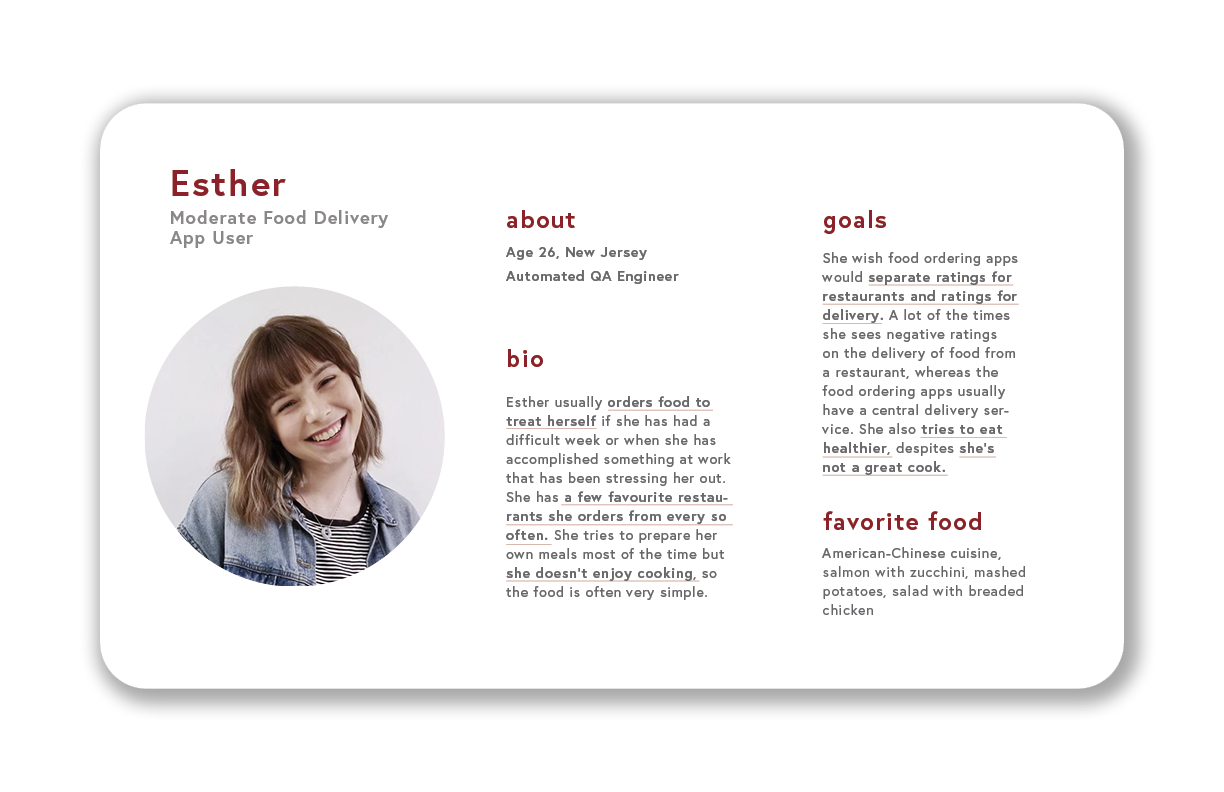
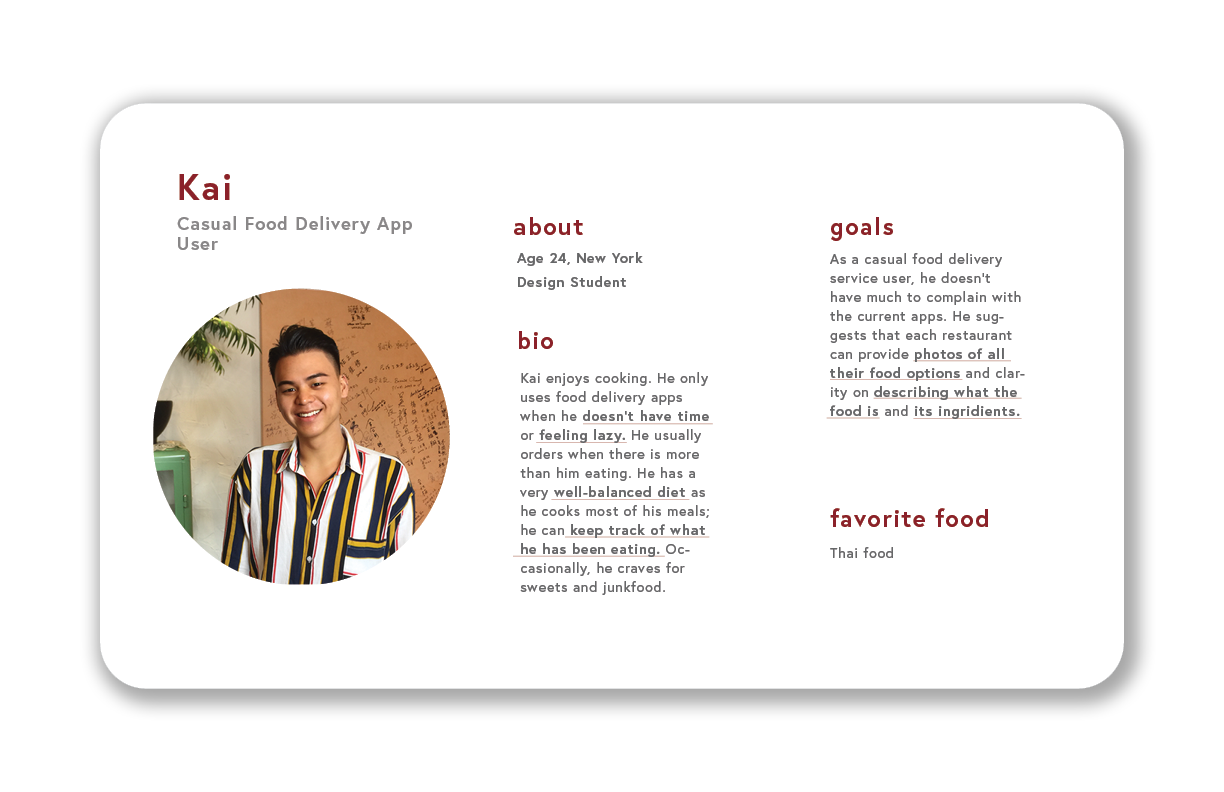
SYSTEM MODEL RE-MAPPING
A More Sustainable Ecosystem
“How can I regulate my diet while enjoying the convenience of food delivery to cope with my busy lifestyle?”
After thorough research to understand the users, I mapped out a user journey to identify the relationships between customers, food providers, and delivery service for Bento.
What Brian needs:
A personalized meal plan custom-made for his small appetite
A calendar that plans out his meals for the week
What Anna offers:
Customizing meals based on customers’ diets and preferences
Providing transparent info on ingredients sources
In charge of maintenance of the returned containers
*Benefits for Anna: she decides how many servings she can make at times
What Robert does:
Delivering food to customers’ doors as well as picking up used containers and utensils
By picking up utensils, customers compensate Robert for the service
Info Architecture
Low-Fi Wireframes
Digitalized Mid-Fi Wireframes
With a data flow in mind, I created a mid-fi iteration on Adobe XD to explore different interactions and opportunities.
THE SOLUTION
Hi-Fi Prototype
HIGHLIGHT 1: HOME
Personalized Home Page
When users open the app, I want it to be an effortless experience; a customized home page that directly showcases their preferences with clear visualization and seamless navigation. The goal is to eliminate user struggle on browsing through millions of options not knowing what to choose.
HIGHLIGHT 2: CUSTOMIZED NAVIGATION
Diet Preference Filter
To ensure users can receive the results they want with the least effort, I created a filter feature with detailed yet straightforward options to enhance the accuracy of search results. Going from meal size to personal preference options to alleviate the hassle of meal search.
HIGHLIGHT 3: RESTAURANT LIST
Visualizing Search Results
Different from traditional food delivery apps, one of the highlights of Bento is home-cooked meals. My goal was to design an interface that displays photos of the food and the meal providers. Without redundant text on a small phone screen, I emphasized the info hierarchy by visualizing search results.
HIGHLIGHT 4: MEAL PLAN SUBSCRIPTION
Meal Planner
To simplify the effort of planning a week-long meal plan, I placed food images as icons to improve the affordance; users no longer have to read through written texts on the menu before making decisions. The design aims to let users understand how the subscription works at first glance.
HIGHLIGHT 5: TRACKING SYSTEM
Recycling Used Containers
To improve environmental consciousness in the current food delivery ecosystem while maintaining the convenience of getting your food at door, every meal is packed in a reusable container. Once users finish their meals, simply leave the containers at door for pickup. This novel system can cut down one-time-use packaging without extra effort.
TAKEAWAY
Skills Learned & Moving Forward
Lesson Learned
User feedback matters: Talking to people and pinpointing their needs and wants helped me immensely prior to identifying user flow and tangible goals.
Be audacious: Creating an app for a new service is scary. While holding on to my experience in Industrial Design, I’ve had fun in this passion project and was able to implement different design methodologies from my past experience. The process pushed me constantly to learn new knowledge and tools along the way.
Next steps…
There’s always room for improvement. Due to time constraints, I wasn’t able to freshen out all the features. Moving forward, I’d like to focus more on developing the user flow for food providers, as well as addressing concerns on food safety issues and related legal liability; a transparent step-by-step user cycle on food prep is needed to improve its service design.


















